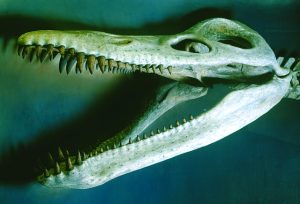Episode 403: Predator X
Description
Thanks to Eesa for suggesting this week’s topic, the pliosaur Predator X!
Further reading:
Predator X / Pliosaurus funkei [you can find lots of interesting pictures here, some artwork and some skeletal diagrams]
Kronosaurus had a big skull with big teeth:

Show transcript:
Welcome to Strange Animals Podcast. I’m your host, Kate Shaw.
We’re one week closer to Halloween, and that means the monsters are getting more monster-y, at least in name, although I wouldn’t want to meet this one in person. It’s referred to as Predator X, and thanks to Eesa for suggesting it!
Fortunately for everyone who likes to swim and boat in the ocean, Predator X has been extinct for around 145 million years. It’s a type of marine reptile called a pliosaur, Pliosaurus funkei, but there was nothing funky about it. It was huge, fast, and incredibly strong. Also, the funky part of the name comes from the couple who originally discovered the first specimen, who had the last name of Funke.
We only have two Predator X specimens right now, both of them found in the same rock formation from a Norwegian island. The remains were first discovered in 2004 but the process of recovering them took many years. Because winters in Norway are very cold, the exposed rocks were subject to freezing temperatures that had broken a lot of the fossils into fragments, and some of the fossils crumbled into pieces as they dried out. All told, 20,000 pieces were recovered and painstakingly fit back together like a gigantic jigsaw puzzle made of fossilized bones.
Neither specimen is complete but we have enough bones that scientists can estimate the animal’s size when it was alive—and it was huge! It probably grew up to 39 feet long, or 12 meters, and some individuals would certainly have been bigger. Initial estimates were even longer, up to 50 feet, or over 15 meters, but that was before the specimens were fully studied.
Like other pliosaurs, predator X had a short tail and big teeth in its long jaws. Its head was massive, around 7 feet long, or 2 meters, and its front flippers were probably about the same length. It had four flippers, and researchers think its front flippers did most of the work of swimming, with the rear flippers acting as a rudder, but it could probably use its back flippers for a little extra boost of speed when it needed to. But it was a strong, fast swimmer no matter what, probably as fast as a modern orca, and very maneuverable. It had to be, because it ate other marine reptiles like plesiosaurs that were themselves very fast swimmers. It undoubtedly also ate sea turtles and fish, and probably pretty much anything else it could catch. It didn’t eat whales because this was long, long before whales evolved.
Predator X got its nickname from reporters back when the paleontologists thought it was 50 feet long. It didn’t have a name yet so it got called Predator X because that sounded impressive (and it is), but it isn’t the only giant pliosaur known.
Kronosaurus was originally described in 1924 from fossils discovered in Australia, and current estimates of its size agree that it could probably grow to around 33 feet long, or 10 meters. This may be a low estimate, though, because the size of the biggest skull found might have been over 9 feet long, or 2.85 meters, although the skull isn’t complete so its full size is just an estimate. Pliosaurs do have big heads, but if Kronosaurus’s skull really is longer than predator X’s skull, it was probably a bigger animal overall.
Kronosaurus’s fossils have only been found in an ancient inland sea that covered most of Queensland and Central Australia until about 100 million years ago. It was probably a relatively shallow, cold sea, and although it had all the marine animals you’d expect for the time, like sharks, ammonites, ichthyosaurs, plesiosaurs, lungfish, sea turtles, and lots more, Kronosaurus was the apex predator. It was so big and deadly that a full-grown Kronosaurus didn’t have to worry about anything in the water.
Trying to figure out how big an extinct animal was from its fossil remains isn’t easy. It’s rare that an entire skeleton is discovered, so scientists have to make estimates of how big the missing pieces were, such as how long its tail was. Then they have to deal with the problem of how rare it is to find fossil specimens in the first place. The fewer specimens we have, the harder it is to decide how big a species may have grown overall. If you have 100 fossilized animals, you can measure them all and get a good idea how big most adults of that species got. If you have one fossilized animal, you don’t know if that particular individual was extra small or average or maybe the biggest one that ever lived.
All that aside, some of Kronosaurus’s teeth grew an entire 12 inches long, or 30 cm. Predator X had teeth the same size. So if you somehow invent a time machine and go back to the Cretaceous or Jurassic to look around, you might want to stay out of the water—or just bring an extra strong shark cage.
You can find Strange Animals Podcast at strangeanimalspodcast.blubrry.net. That’s blueberry without any E’s. If you have questions, comments, or suggestions for future episodes, email us at strangeanimalspodcast@gmail.com. We also have a Patreon at patreon.com/strangeanimalspodcast if you’d like to support us for as little as one dollar a month and get monthly bonus episodes.
Thanks for listening!





